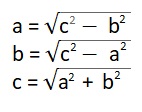The Pythagorean theorem is a fundamental relation in Euclidean geometry between the three sides of a right triangle.
It states that the square of the length of the hypotenuse (the side opposite the right angle) is equal to the sum of the squares of the lengths of the other two sides.
This theorem can be written as an equation relating the lengths of the sides a, b and c, often called the Pythagorean equation:
a² + b² = c².
Pythagoras was an ancient Greek philosopher and mathematician who was born around 570 BC on the island of Samos. He is best known for the theorem that bears his name, the Pythagorean theorem. Pythagoras founded a religious and philosophical school called Pythagoreanism, which became legendary and a source of discussion even in ancient times. The school was known for its strict rules and secrecy, and all new mathematical results for several centuries were attributed to Pythagoras’ name.
The Pythagorean theorem can be used to find the length of one side of a right triangle if the lengths of the other two sides are known. For example, if you know the lengths of the two legs of a right triangle (the sides that form the right angle), you can use the Pythagorean theorem to find the length of the hypotenuse (the side opposite the right angle). Similarly, if you know the length of the hypotenuse and one leg, you can use the theorem to find the length of the other leg. The theorem can also be used to check if a triangle is a right triangle. If the square of the length of the longest side is equal to the sum of the squares of the lengths of the other two sides, then the triangle is a right triangle.

